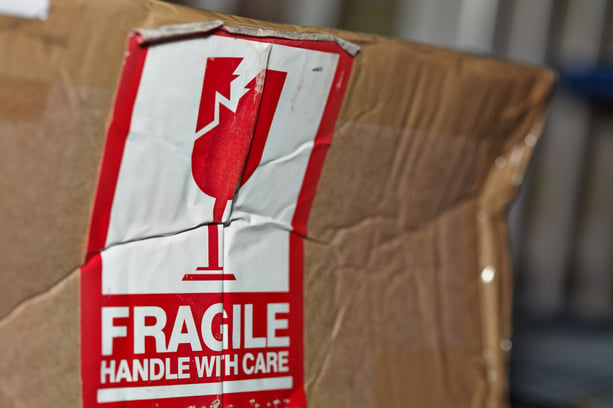REDWOOD LOGIN
Redwood PortalLTL
SCS
SCS Support
Rockfarm
 A major expense that all shippers deal with is damaged freight. Whether it’s caused by the carrier in transport, at a freight terminal, or by the recipient, the reality is that freight damage can significantly impact a shipper’s business operation. However, a smart shipper understands that most damage to their freight can be avoided.
A major expense that all shippers deal with is damaged freight. Whether it’s caused by the carrier in transport, at a freight terminal, or by the recipient, the reality is that freight damage can significantly impact a shipper’s business operation. However, a smart shipper understands that most damage to their freight can be avoided.
To avoid damage to your important and valuable freight, we’ve created this list of best practices that all shippers from retailers to manufacturers should follow.
There are several issues that can cause damage to products and freight during transport. However, what’s not commonly known is the true cost of this troublesome issue. Obviously, the damage done to the freight is a hit to your inventory. But there are several ancillary costs that can impact your business more than the simple damage of freight.
• Potential of lost business: It’s often said that a first impression can leave a lasting mark. There is nothing worse than receiving a phone call from an upset customer letting you know that they received damaged freight. While in most instances, they will be understanding, you simply can’t guarantee that this will be the case.
• Increased shrink levels: Shrink is a term that all retailers and manufacturers understand all too well. It’s actually one of the leading culprits of ‘controllable’ expenses that can impact a P&L statement. Many astute blog readers will notice that we indicated that this is a controllable expense – below we’ll explain why.
• Disruption of service: Obviously if your freight is damaged in transit, replacing the freight is the next logical step. If the product is a specialty one that requires unique manufacturing, it can cause a disruption in your production schedule. This might trickle down to other customers if not properly managed.
As you can see, it’s not just the damage to freight that can cost a company lost revenue, reduced efficiency or even poor sales in the future. To reduce the potential of the above items impacting your company, follow these best practices for preparing a shipment noted below.
The best way to avoid damage to freight is to ensure it’s properly packaged for the specific mode of transportation. Most people realize that packaging is the smallest cost to the overall logistics budget, but you’d be surprised how many companies skimp on using low-quality supplies or methods for packaging to protect their valuable freight. Skimping on the packaging can have a significant impact on the potential of damaging your freight.
As such, the first best practice to follow is to create packing procedures for your commodities that will protect it for specific modes of transport. If you sell one item that can be shipped via air, ground, or LTL/FLT, make sure to create a system of controls or packaging procedures that will protect your items.
While these steps are general, you should always consult with a professional to determine the exact procedures for packaging your materials.
• Never utilize used materials.
• Never use packaging supplies with holes, tears, or water damage.
• For pallets, make sure all boards are intact. Never use a damaged pallet.
• Always secure your freight. Use shrink wrap, metal bands, or the appropriate materials to reduce the potential of freight shifting during transit (which is a leading cause of damaged freight).
• Use impact protection. If you have commodities that are delicate in any way, it’s vital to protect it by using impact protecting packaging. Items like cardboard, bubble wrap, bio-degradable plastics or foam are also great to use in packaging. However, it’s important to secure the items in a solid crate.
• Use High-Quality Adhesives: Packaging that simply opens due to heat, cold, or frequent movement is typically attributed to poor quality adhesives. Whether it’s the tape you use, or the glue, it’s vital to use the best materials. Always use a strong packaging-specific tape that is at least two inches wide. It is also a good idea to use water-activated paper tapes that have industrial quality glue. NEVER use masking tape, string, or cellophane tape to secure items for shipment.
• Load the trailer correctly: This step typically falls outside of the responsibility of the shipper. However, you have rights to review the loading of your freight by the carrier. In fact, it might be a good idea to record this step – especially if you have highly valuable freight being shipped.
• Use high-quality labeling materials: Another cause of freight damage is that commodities that require special handling simply are not notated correctly – or the warning labels have fallen off. To avoid this potential, make sure to label your shipments correctly (as recommended by the carrier) which can also protect you for potential freight damage claims.
The final best practice is a recommendation that can reduce the potential of damaged freight – especially for those who are not willing or believe they have the experience to handle all of these best practices. Working with an experienced third-party logistics provider has been shown to reduce the potential of damage to freight. This is due to the fact that the best 3PL’s follow these steps and have years of experience handling and preparing freight for shipment – with multiple carriers and modes.